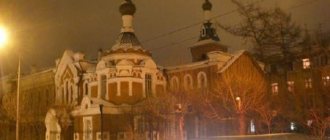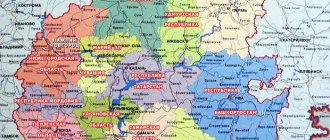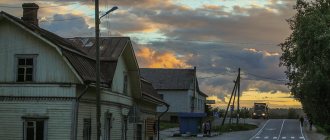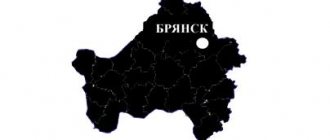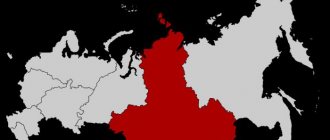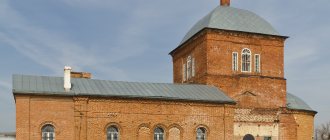YEAR OF CREATION
The Yaroslavl region was created in 1936. The administrative center is the city of Yaroslavl, founded in 1010 by Prince Yaroslav the Wise.
TERRITORY
The region's territory occupies 36.4 thousand sq. km.
POPULATION
Population: 1.241 million people. 601 thousand people live in Yaroslavl. 82% of the population lives in cities.
GEOGRAPHICAL POSITION
The Yaroslavl region is located in the northern half of the European part of Russia, bordering on the Moscow, Vladimir, Vologda, Kostroma, Ivanovo and Tver regions.
Yaroslavl is a large, rapidly developing administrative and business center in the northeast of Moscow.
The distance from Yaroslavl • to Moscow is 280 km • to St. Petersburg – 850 km • to Nizhny Novgorod – 330 km.
CLIMATE
The region is located in the temperate continental climate zone. The average long-term air temperature in January is 11°C, in July +18°C. The average annual precipitation is 520-690 mm. The average duration of the growing season is 150-170 days.
NATURAL RESOURCES
The territory of the region is crossed by rivers with a total length of 20 thousand km. The area of the lakes is about 5 thousand square meters. km. In total, there are more than 80 lakes in the Yaroslavl region, the largest of which are Lake Nero and Lake Pleshcheyevo. On the Volga River, which has a length of 340 km in the region, there are 2 reservoirs: Uglich and Rybinsk - the largest in Central Russia. The total reserves of surface water are 38 cubic meters. km.
The total forest area is 1.8 million hectares. The average forest cover of the region is 45.3%. Primary and secondary timber processing is carried out in the region.
The main natural resources of the Yaroslavl region are peat, sand and gravel materials, construction sand and sapropel. The region's mineral resource base was formed over 70 years, from the twenties to the eighties of the twentieth century. As a result of geological exploration work in the region, 1,169 deposits of various minerals were identified, including 1,044 deposits of peat and sapropel.
The subsoil of the Yaroslavl region has the geological prerequisites for identifying unconventional minerals: refractory and bentonite clays, titanium-zirconium sands, glauconites, vivianites, uranium, gold and hydrocarbons.
There are 11 types of minerals distributed in the region, classified as common. A significant part in the structure of reserves is occupied by sand and gravel material and construction sand.
What holiday is it today?
December 16, 2021, Thursday
Today are holidays, events: Events that happened on December 16 in the world, in different years Tomorrow: Day of Strategic Missile Forces Day of Employees of the State Courier Service Memorable date in the military history of Russia: Capture of the Ochakov fortress in 1788
Today is the Orthodox holiday of the Prophet Zephaniah. Reverend Savva of Storozhevsky, Zvenigorod. Martyr Angelis... Tomorrow: Great Martyr Barbara and Martyr Juliania of Iliopolis. Venerable John of Damascus...
Today is a national holiday: Day of World Silence and Silence... Tomorrow: Barbarian Day...
Seasons
Seasons, four periods of the year (spring, summer, autumn and winter) characterized by certain average temperatures. The period during which the Sun passes through one of these sectors is called the season. Spring in the Northern Hemisphere and autumn in the Southern Hemisphere begin when the Sun passes through the initial circle of declination and its right ascension is 0° (vernal equinox). Summer in the Northern Hemisphere and winter in the Southern Hemisphere occur when the sun's right ascension is 90° (summer solstice). Autumn in the Northern Hemisphere and spring in the Southern Hemisphere begin when the sun's right ascension is 180° (autumnal equinox). The beginning of winter in the Northern Hemisphere and summer in the Southern Hemisphere is considered to be the winter solstice, when the direct ascension of the Sun is 270°... Next: Seasons. Russian folk calendar. Monthly words...
Rostov the Great.
Rostov the Great is the living soul of the Yaroslavl Land!
Not far from Lake Nero is the famous white stone Rostov Kremlin . This ancient Russian princely fortress is surrounded by powerful walls with towers. Historically, this was the Bishop's Court - the residence of the Rostov metropolitans and bishops. Metropolitan Jonah Sysoevich was especially famous.
Under him, the Assumption Cathedral was renovated and a magnificent belfry of 13 bells was built. The largest of them was named “Sysoy”.
Rostov the Great is the most famous center of bell ringing! Tourists often hear the music of church bells!
The churches of the Rostov Kremlin impress with their frescoes. The fresco paintings of the churches “John the Evangelist”, “Resurrection” and “Savior in the Entrance” have no analogues in the world.
The Rostov Kremlin wins the hearts of its guests with the Museum of Church Antiquities and Enamel. Scenes for the famous film “Ivan Vasilyevich Changes His Profession” were filmed in the ancient Rostov Kremlin.
Rostov the Great surprises tourists: the Spaso-Yakovlevsky and Abrahamtsevo monasteries, the fabulous Lake Nero, the Nativity Convent, the Church of Isidore the Blessed on the Ramparts.
Varnitsky Holy Trinity Sergius Monastery (15th century) - the birthplace of Sergius of Radonezh. In the 20-30s of the 20th century, the monastery was practically wiped off the face of the earth. At the end of the 20th century, with the return of it to the Russian Orthodox Church, it was rebuilt, restored and is now more beautiful than it was before.
Leaving Rostov the Great and its famous Kremlin, this pearl of Russian art, visitors take with them a feeling of admiration for the talent of the remarkable craftsmen from among the people and gratitude to the city residents for the loving preservation of priceless monuments of history and material culture.
Folk calendar about every day
Every day one season always replaces another and this determines a person’s way of life. In connection with this, a folk calendar was formed in which there were practically no nameless, unmarked days. Every day was special, had its own purpose. All this was determined by climate conditions and astrological phenomena.
A calendar is a system for counting periods of time. The first calendars arose a long time ago, in ancient times, because there was a need to measure time. The word calendar comes from the Latin words caleo - to proclaim and calendarium - debt book. This is due to the fact that in Ancient Rome the beginning of each month was especially proclaimed, and because it was customary to pay debts on the first day of the month. Different peoples counted time differently. Some calendars are based on the changing phases of the moon - lunar calendars; in others - the change of seasons - sunny; in others, the length of the year was coordinated with the change of seasons, and the counting of months was associated with the phases of the Moon. Such calendars are called lunisolar.
In Rus', the calendar was called a monthly calendar. Every day, the month book covered the entire year of peasant life, “describing” day by day, month after month, where each day had its own holidays or weekdays, customs and superstitions, traditions and rituals, natural signs and phenomena. The cyclical nature of the calendar is reminiscent of human life, where spring is youth, summer is heyday, autumn is the time of harvesting fruits (it’s good if there are some, otherwise you can live your life without collecting fruits), winter is the time of wisdom and peace. This cyclicality and rhythm determined the way of life of the farmer. The folk calendar was an agricultural calendar, which was reflected in the names of the months, folk signs, rituals and customs. Even the determination of the timing and duration of the seasons is associated with real climatic conditions. Hence the discrepancy between the names of the months in different areas... Next: Folk calendar...
About the climate
The climate in the region is moderate, with clearly defined features characteristic of each season. The beginning of autumn is especially attractive. As a rule, until mid-October there are dry and warm days, which are replaced by prolonged drizzling rains.
There are no severe frosts in the region in winter, as well as severe heat in the summer. This is due to the high humidity of the climate, because the level of evaporation here is not very low, since the area of the Yaroslavl region is literally covered with various bodies of water.
As for temperature indicators, in July the thermometer stays at +18 degrees Celsius, and in January it rarely drops below -12.
Fishing calendar for every day
The fishing calendar should not be taken as an absolutely indisputable truth. Fish biting is greatly influenced by a whole range of natural factors, as well as the influence on the nature of man himself. You must not forget that the fish’s bite depends and is determined not only by the calendar dates and biological cycles of their life, reflected in the calendar, but also, no less, by the state of their habitat; the bite also depends on weather conditions: air and water temperatures, cloudiness, wind direction and strength, etc... Next: Fishing calendar...
Orthodox calendar about every day
Orthodox calendar: Orthodox, Church and Christian holidays.
The church year is an alternation of weekdays and holidays. On weekdays, a person is called to work “by the sweat of his brow to earn his bread.” Holidays are given in order to feel liberation, to rise above the bustle and routine of the world, to feel involved in the highest of worlds, “where there are no illnesses, sorrows and sighs, but endless life.” Since ancient times, holiday cycles have been associated with the seasons. The pagans associated them with the worship of the forces of nature, the cult of which in the Old Testament was replaced by gratitude to the Creator for the universe. And although the connection between holidays and the seasons has not completely lost its power, since God is present in everything, in the plant and animal world, in human works, it nevertheless faded into the background, giving way to a spiritual foundation built on the Sacred Scriptures. The history of Orthodox holidays dates back to the times of the Old Testament. Each of the Orthodox holidays is dedicated to the remembrance of the most important events in the life of Jesus Christ and the Mother of God, as well as the memory of saints... Next: Orthodox calendar...
Sights of the city of Myshkin:
Myshkin is a member of the Association of Small Tourist Towns of the Volga Region . In 2011, it received more than 160 thousand tourists, and in 2008 there were only 10 thousand. The growth is huge! Now there are 30 objects in the city for display to tourists.
Myshkin is a town of amazing museums! You won’t find such fun museums anywhere else:
- The famous, only “Mouse Museum” ;
- Tourist complex "Myshkiny Palata";
- Museum "Russian Valenki";
- Museums of the capital of pilots and equipment;
- An exhibition of wooden architecture and the oldest “House of Crafts” with a working pottery workshop and forge.
- Mill and miller's house;
- Ethnographic exhibition "Len";
- Historical and Household Museum;
- Museum of vodka maker P.A. Smirnov;
- "Boat of Peter I" museum-estate;
- "Bot Fortune". Exposition;
- Museum " Crafts of the Yaroslavl Region " ;
- Museum of Katskars in the village of Martynovo;
- Museum " Merchant's Estate " .
Russian folk calendar for every day
The word “sign” comes from the word “notice”, i.e. observe. As a result of observing what happens around a person every day, he accumulates life experience. This knowledge was passed down from generation to generation, carefully preserved and people trusted it as a sacred book. Many signs have come to us from the depths of centuries without losing their knowledge. Each of us is free to choose: to dismiss all this as an absurd superstition or to take a closer look at the signs and take the centuries-old experience of generations more seriously. Most of us, when taking exams, ask them to scold them, boasting about some kind of good fortune or luck, spit so as not to jinx them or knock on wood, take a detour if a black cat crossed the road, are afraid of the number 13 and much more. And who among us does not have lucky things, numbers? Who has never resorted to the help of fate at least once in their life, who has not believed in secrets? It’s as if everything connected with signs is hidden somewhere deep in our subconscious. Often we remember them mechanically, unconsciously, or just as a joke. But, undoubtedly, the signs contain a lot of accurate knowledge and practical wisdom of our ancestors. They cover all the characteristic, often difficult to perceive, natural phenomena. Signs have preserved a lot of what was in old folk holidays and customs; they help predict the weather, grow crops... Next: Folk signs...
Cities of the Yaroslavl region
Yaroslavl. Population 600 thousand people, regional center. Located along the banks of the Volga, it has a 1000-year history; The city center is beautiful, you can admire the Kremlin, many buildings from the 17th-18th-19th centuries have been preserved. It is located mainly on the right bank of the Volga, connected to the left bank areas by 2 bridges. The M8 federal highway passes along one, capturing part of the city.
Rybinsk. Population 200 thousand people. Located on the Volga, within the city boundaries there is the Rybinsk waterworks, the locks and the dam of the Rybinsk Reservoir. The main attraction is the city cathedral and the city museum building, which look good from the river or the recently renovated embankment. Excellent hunting in the city area, fishing in the reservoir.
Pereslavl-Zalessky, Rostov, Uglich, Tutaev . Population from 42 to 32 thousand people. All cities with a rich history, all once had much greater importance than now, all have many architectural monuments from different centuries (we especially note Rostov and Uglich in this regard). At the same time, any manufacturing industry is almost completely absent; cities exist on subsidies from the regional budget. The tourism industry could be a great help, but alas, they don’t know how to properly preserve and present historical monuments in Rus'... There was once a Golden Ring, and these cities were part of it, but where is it now...
Gavrilov-Yam, Danilov. Population from 17 to 15 thousand people. In principle, the above can be transferred here, only the pipes are lower and the smoke is thinner. In Gavrilov-Yama there is a flax mill that produces wonderful fabrics, and Danilov is a large railway and highway junction. Actually, that's all.
Holiday calendar, dates and events of the year
All state and professional holidays in Russia, including significant World and International holidays, and other equally interesting holidays and events about every day.
The holiday has always kept pace with the history of mankind. Social time can be divided into three types: everyday life (weekdays), weekends and holidays. Everyday life is a series of practices repeated day after day and every day (work). Weekends are regular breaks from the rush of everyday life. It is believed that on weekends a person should restore his strength after working days. Day off, non-working day. A holiday is a day of celebration established in honor or in memory of someone or something. A day or series of days celebrated by the church in memory of a religious event or saint... Next: Calendar...
Uglich.
Uglich is famous for its historical and art museum. 5 monuments of ancient Russian art are open for visits here:
- Temple of “Tsarevich Dimitri on the Blood” (1692), erected on the very spot where the young son of the Russian Tsar Ivan the Terrible died. The theme of the “Uglich Events” at the end of the Time of Troubles on May 15, 1591 is depicted in frescoes on the western wall of the cathedral and is of great artistic value;
- Chambers of the Uglich appanage princes of the 15th century with the original coat of arms of the city of Uglich. There is an exhibition reflecting the Petrine and Medieval periods of the city’s history;
- Epiphany Cathedral;
- Transfiguration Church;
- Gallery of painting and contemporary Orthodox art “Under the Cover of Grace” and exhibition hall, operating since 2007.
Come to the Yaroslavl region, enjoy the silence and splendor of nature, the majestic ensembles of monasteries and take with you a piece of the immense Russian soul!
Articles on the topic of holidays in Russia:
Novgorod region: Veliky Novgorod and attractions of the Novgorod region. Weekend Tours . Gold ring of Russia. Holidays on the Black Sea in Russia: Anapa, Gelendzhik, Sochi.
Prayer book, Orthodox prayers for every day
Prayer is the most powerful means for healing all illnesses - both physical and mental. Prayers can be laudatory or grateful, petitionary and repentant. If we have offended God, sinned, we must ask Him for forgiveness, that is, repent. Such prayers are called repentant prayers. If everything is fine with us, if we and our loved ones are healthy and prosperous, if we have a place to live, something to wear, something to eat, we must glorify and thank God for this. Such prayers are called praise or thanksgiving. If some misfortune, illness, trouble or need happens, you need to ask God for help. Such prayers are called petitionary... Next: Orthodox prayers...
Zodiac, astrological, eastern calendar. Zodiac signs
In ancient times, to establish the calendar, priests used knowledge of the positions of all the planets. Before the reform of Peter 1, the New Year was celebrated on the Day of the Autumn Equinox. On this day, according to ancient legend, the most peaceful treaty was concluded between the Great Race (ancient Slavs) and the Great Dragon (ancient Chinese) and it was approximately 7518 years ago... For the ancient Slavs, the calendar month corresponded to the lunar cycle from new moon to new moon, taking into account such Thus, the relationship of the entire annual cycle with astronomical and natural phenomena. There was no coherent calendar system. The main natural phenomena are still considered to this day to be the days of the solar equinox and solstice - the Slavic holidays Maslenitsa, Kupala, Ovsen and Kolyada. But during the time of Peter 1, all ancient Slavic calendars were abolished and a new Western European calendar from the Nativity of Christ (Julian calendar) was introduced, while the beginning of the calendar was moved to January 1. The Julian calendar (old style) did not take leap days into account and accumulated one extra day every 128 years. After the October Revolution in 1918, the Gregorian calendar (new style) was introduced in Russia, according to which an amendment of 13 days was introduced. The calendar of the ancient Slavs was based on two planets: the Sun and the Moon. And now they don’t use anything at all. The calendar has become static. There is no such thing as the calendar, it turns out, resting on some planet. Nobody even knows about it. There are just some standard numbers, there are months and holidays. The calendar is based on the Sun and Moon. Why is this so? Because these two luminaries influence the Earth. The Earth revolves around the Sun, and the Moon revolves around the Earth. And these two luminaries create the atmosphere on the planet. From here the calendar is built... Next: Astrological calendar...
Yaroslavl.
Yaroslavl is the main pearl in the crown of the Yaroslavl land.
Yaroslavl is a white-stone city with an extraordinary aura, a breath of history, magnificent gardens and parks, ancient and modern church domes, and rare sights.
In 1010, Yaroslavl was founded as a fortress city, and the ancient chroniclers first started talking about it in 1071. In 2010 the city turned 1000 years old!
Yaroslavl is a whole city-museum in the open air! There are about 800 historical and cultural monuments in the city! In 2005, the city of Yaroslavl was included in the list of historical monuments of the World Cultural and Natural Heritage under the auspices of UNESCO.
The main attractions of Yaroslavl:
- Yaroslavl Strelka;
- Yaroslavl Historical and Art Museum-Reserve;
- Transfiguration Cathedral;
- Church of John the Baptist;
- Church of Elijah the Prophet;
- Metropolitan Chambers;
- Volga embankment;
- New Assumption Cathedral (2004-2010);
- Church of St. Nicholas the Wonderworker (St. Nicholas Chopped City);
- Stele "Monument to the 1000th anniversary of Yaroslavl";
- Planetarium. Museum "Cosmos";
- The first private museum in Russia “Music and Time”. "Porcelain House";
- Landscape-type zoo;
- "Gazebo of Love";
- Memorial Museum-Estate of Nekrasov;
- Children's Museum "Grandfather Mazai".
Yaroslavl Strelka is the site of the founding of Yaroslavl on the Upper Volga by Prince Yaroslav Vladimirovich as the Volga outpost of Rostov the Great.
Strelka is a high cape at the confluence of the Volga and Kotorosl rivers.
The Yaroslavl Strelka gives rise to a whole ensemble of churches that are located throughout the Volga embankment. On the territory of Strelka there are the Metropolitan Chambers and the Church of St. Nicholas the Wonderworker (St. Nicholas the Rubeny Gorod) built in 1695. The Yaroslavl Spit was transformed for its 1000th anniversary: a snow-white new Assumption Cathedral was built and a 20-meter Stela was erected - “Monument to 1000 Years of Yaroslavl” ! Today Strelka is decorated with fountains and a beautiful landscaped park. Here city residents and numerous tourists can admire the daytime and evening light and sound show of singing water.
Yaroslavl Strelka, “Monument to 1000 years of Yaroslavl”!
On the Volga Embankment , the “Gazebo of Love” is comfortably located - a popular place of solitude since 1840 for citizens and guests of Yaroslavl.
Spaso-Preobrazhensky Monastery. Currently it has the status of the Yaroslavl Historical and Art Museum-Reserve. The Spaso-Preobrazhensky Monastery is famous for its main temple - the Spaso-Preobrazhensky Cathedral. The Transfiguration Cathedral is the oldest building in Yaroslavl. It was erected in 1506-1516 on the foundations of the original construction of 1216-1224. Nearby is the bell tower of the cathedral. The belfry of the ball was built in the first half of the 16th century. It was built on in 1808, and finishing work was completed by 1824. Now there is an observation deck here. It offers a stunning view of the domes, bells and the entire architectural ensemble of the monastery. On the territory of the complex there is an ancient library, Abbot's Chambers (17th century), Refectory and Cross Church (16th century). “The Tale of Igor’s Campaign” is the most famous historical monument of ancient Russian literature. It was found in the early 90s of the 18th century by the collector of Russian legends, Count A.I. Musin-Pushkin right here in the Spaso-Preobrazhensky Monastery. The monument “The Oath of Prince Pozharsky” solemnly greets visitors to the museum-reserve. It was installed in 2010 on the territory of the Spaso-Preobrazhensky Monastery for the 1000th anniversary of Yaroslavl.
The Church of John the Baptist is a fantastic silhouette and the only 15-domed temple in ancient Russian architecture, built in the 17th century. The Church of John the Baptist is located on the banks of the picturesque Kotorosl River in Tolchkovo. This is a monument of world significance, recommended by UNESCO for showing to tourists. It surprises with its brick patterns and tiles. In terms of the number of mural paintings based on Biblical scenes, and there are about 500 of them, this temple is the very first in the world! The most significant of them were decorated in the form of crowns of silver coinage in the 18th century. Sixteen of the best masters, under the guidance of the hereditary icon painter Dmitry Grigoriev-Plekhanov and the young icon painter Fyodor Ignatiev, were engaged in its interior wall painting. This amazing work was completed in just one year (from June 5, 1694 to July 6, 1695). The temple fascinates with its carved golden iconostasis from 1701 in the Baroque style, and in the chapel of the Kazan Wonderworkers with a unique carved gate from the mid-17th century. At the beginning of the 18th century, a six-tier bell tower in the Moscow Baroque style was built next to the church. The church and bell tower look like a picturesque union; they are the tallest in Yaroslavl (up to 45 meters)! The image of the “Church of John the Baptist”, as a symbol of “the most Russian”, appeared on the main popular banknote of the 21st century - the 1000-ruble Russian banknote. And today, against the backdrop of nature with paths overgrown with grass, this temple looks especially majestic and unique!
Church of Elijah the Prophet (1647-1650) is the most beautiful place in Yaroslavl! The Church of Elijah the Prophet is the main architectural structure of the center of Yaroslavl. The iconostasis of the central temple of the church is unique, and the interior wall paintings and the “Harvest” fresco from 1680 are also impressive. The Church of Elijah the Prophet is the center of the square of the same name according to the reconstruction plan of 1778, from which the streets radiate. The Temple of Elijah the Prophet is valuable because it has retained its original appearance and outwardly resembles the picturesque mansions of the 17th century. This 4-pillar, five-domed temple on a basement is surrounded on three sides by a two-tier gallery, to which two openwork porches in the form of “houses” lead. All architectural details are designed to emphasize its lightness and upward aspiration. The tented bell tower is adjacent to the northern corner of the temple. On major Christian holidays during the summer season, church services have been held since 1989, when the main altar of the church was consecrated again.
Church of Elijah the Prophet in Yaroslavl
The Metropolitan Chambers opened on April 18, 2012 after renovation and delight citizens and tourists with the updated interior of the halls and modern lighting. The walls of each room have their own individual color. Here is the exhibition “Old Russian Art of the 13th-17th Centuries”. In three halls icons are presented according to the time of their creation, and in the fourth – original icons. A new “Hall of Miniatures” has opened in the department of ancient Russian art of the Yaroslavl Art Museum. The hall where the icon “Savior Pantocrator” is displayed - one of the most ancient icons before the “Mongol era”, work from the beginning of the 13th century (there are only 25 of them in the world), is designed in noble, regal burgundy tones. The icon “St. Nicholas” was restored using the layering method. Initially, two layers of the image were applied to it. Here you can admire the 16th century icon of Our Lady of Yaroslavl, who is the patroness of the city. On the icon “Our Lady of Tolga” you can see an image of the Yaroslavl Kremlin and the ancient Assumption Cathedral of the 17th century. The Golden Hall of the Metropolitan Chambers displays icons painted during the “Golden Age” of Yaroslavl (17th century).
On the territory of the Yaroslavl region there are 250 museums , including the first private museum of post-Soviet Russia “Music and Time”, operating since November 1993. The Music and Time Museum is a small mansion on the Volga Embankment. Collected here are: bells and bells, music boxes and organs, antique records and gramophones, musical instruments, clocks and icons. All exhibits are active and in working condition. In the courtyard of the mansion there is a porcelain museum “Porcelain House”. The Music and Time Museum is the brainchild of its creator, collector, actor-magician and director, John Mostoslavsky. Also of interest to tourists and children are: the Nekrasov Memorial Museum-Estate and the Ded Mazai Children's Museum.
Memorial Museum-Estate of Nekrasov in the Yaroslavl region
In Russia, the first public theater was opened in Yaroslavl in 1850 . In 1911 its new building was built. In 1964 it was reconstructed. Today the theater has two halls: Main (with 931 seats) and Chamber (with 120 seats). International theater festivals are held here.
For the 1000th anniversary of Yaroslavl, a “Planetarium” was built in the city - the most modern building of its kind in Russia. The Cosmos Museum was opened in honor of the first female cosmonaut Valentina Tereshkova, who flew into space on the Yaroslavl "Chaika".
A landscaped zoo with open enclosures and the Yaroslavl Children's Railway will appeal to children and adults!
Planetarium and Museum "Cosmos" in Yaroslavl
There is Tunoshna airport in Yaroslavl. There are regular flights to Yaroslavl from St. Petersburg, Kazan, Sochi, Anapa, Simferopol and other Russian cities. Prices for air tickets to Yaroslavl and flight schedules. The most convenient way to get from Moscow to Yaroslavl is by train; the minimum travel time is 3 hours 18 minutes. The city of Yaroslavl offers its guests more than 300 types of accommodation. Prices for apartments and hotels in Yaroslavl.
Dream books online, interpretation of dreams
A dream book is nothing more than an interpreter of dreams and dreams, a translator of dreams. Since ancient times, people have been using dream books; dreams have always been given great importance, and people have often noticed the prophetic properties of some dreams. The dream book can become your faithful assistant every day and throughout your life, thanks to the dream interpreter you can always make the right decisions, the dream book will help you resist temptations in time, and will warn you against wrong steps and frivolous actions. Further…
Administrative characteristics of the region
The total area of the Yaroslavl region is 36,177 square kilometers. This is quite comparable to the territory of any European state. The administrative structure includes hundreds of municipalities.
These include:
- three large districts with centers in Yaroslavl, Rybinsk and Pereslavl Zalessky;
- 10 urban-type settlements and 70 rural ones;
- seventeen municipal districts.
Only the area of the districts of the Yaroslavl region exceeds the size of a country like Monaco. The Yaroslavl district alone, formed in 1929 and located in the eastern part of the region, has an area of 1,936.7 square kilometers.
